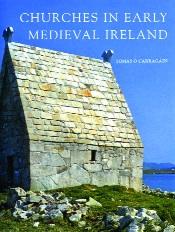Churches in early medieval Ireland ISBN 9780300154443
Published in Book Reviews, General, Issue 3 (May/June 2011), Medieval History (pre-1500), Reviews, Volume 19
Churches in early medieval Ireland
Tomás Ó Carragáin
(Yale University Press, £40)
ISBN 9780300154443
This is ostensibly a comprehensive study of the stone churches of the early medieval period in Ireland—an aim it fulfils admirably. But it is about much more than that. Rarely has one element of the Irish archaeological heritage been treated to such intellectual analysis and international contextualising. The period covered is often proclaimed as Ireland’s ‘golden age’, but the book takes as its jumping-off point a medieval paradox—‘the austerity of the churches compared with the contemporary high crosses, manuscripts and metalwork, all of which are intricately decorated’. These churches probably had lavish interior decoration and—the larger ones, at least—internal divisions, but the buildings themselves were mainly unadorned simple quadrilateral structures, a fact that led to their being effectively ignored by previous scholars. The puzzle is all the greater when they are compared with their counterparts in other parts of Europe. The author solves the problem by showing that the buildings do not result from ignorance of contemporary architecture; rather they are ‘the result of conscious choice made in the full knowledge of the range of models available abroad’. The book argues that the adherence to a simple and continually recycled model is indicative of a ‘conscious decision to favour authenticity over innovation’. The builders of these churches placed high value on cultural conservatism. What was important to them was adherence to a significant original form rather than to architectural and decorative innovation. This was ‘because of what this form had come to represent’. The churches were understood as relics of the ‘saints’ who had built the first churches on the respective sites. It was important to retain as much as possible of that original form—even if the materials changed with their rebuilding over the centuries. As well as their associations with the founding Irish saint they were seen as representing symbolically (and therefore had to ‘imitate’) the Temple of Jerusalem, both in its biblical historicity and as a metaphor for the entire Christianised world.Citing excavation evidence, the book traces the development of Irish churches from early wood and sod-built examples to more sophisticated carpentered structures, before passing to the erection of stone buildings in the eighth and ninth centuries. Their simple unicameral design is traced to the churches of late Roman Britain. A building in Armagh—possibly represented now by the extent of the nave of the Church of Ireland cathedral—appears to have been the first large stone church in the country. Constructed probably to house relics of Christ and the martyrs, it was possibly as big as Charlemagne’s chapel at Aachen. The spread of such churches from 900 onward, with the rate increasing significantly after 1050, is described. Some of them had details ‘copied’ from their timber forerunners. The author points out that most of the churches built before 1050 resulted from royal commissions, arguing that they should be ‘understood as one of the clearest archaeological manifestations of early medieval royal authority in Ireland’. Of course there were regional differences, such as the relative absence of stone churches in the north—especially the north-west. Unlike the patronage of the royal authorities in the midlands, the absence of such buildings throughout the Eoganacht territories in Munster is noted. Between 950 and 1050, however, there was an increase of stone churches there, built by the succeeding Dál Cais dynasty (Brian Boru and the O’Briens). The author notes that some of those Dál Cais churches were specifically intended ‘to invent an illustrious past for sites that had previously been relatively obscure’ but which they wished to promote for political reasons. Such secular intentions probably lay behind the construction of many churches in medieval Ireland.Ó Carragáin is fascinating in retrieving the more abstract aspects of these structures, such as the Christological symbolism attached to details like the roof finials. He distils large amounts of information from the study of minutiae such as doors and windows. He proceeds from an examination of such concrete details to an archaeology of the ceremonies that would have been held within the buildings. His insight into the minds of the medieval people who built and used these churches is a triumph. At times the book reads like a discourse between a medieval contemporary explaining the rationale of the buildings and the author interrogating and interpreting him (almost certainly it would have been a ‘him’). He shows that the layout of the enclosures in which the churches stood—their ‘symbolic urbanism’—was intended to evoke the sacred cities of Jerusalem and Rome. The multiplication (rather than the enlargement) of churches at the Irish sites probably resulted from liturgical factors, while the separate shrine chapels housing the remains of the founding saints would also become the foci of a variety of social functions and public ceremonies, such as the taking of oaths.This is not just an important book. Perhaps even more valuably it is an exciting book, opening up a previously largely relegated subject. A short review like this cannot hope to do it justice. It is beautifully designed and illustrated, and appropriately appears in a prestigious international series. Although part of an academic discourse, the style of the book makes it easily accessible for any interested reader. Its blend of detailed description and discussion—with summaries at the end of each chapter—makes its highly original theses very easy to follow. HI
Brian Lacey is CEO of the Discovery Programme.
















